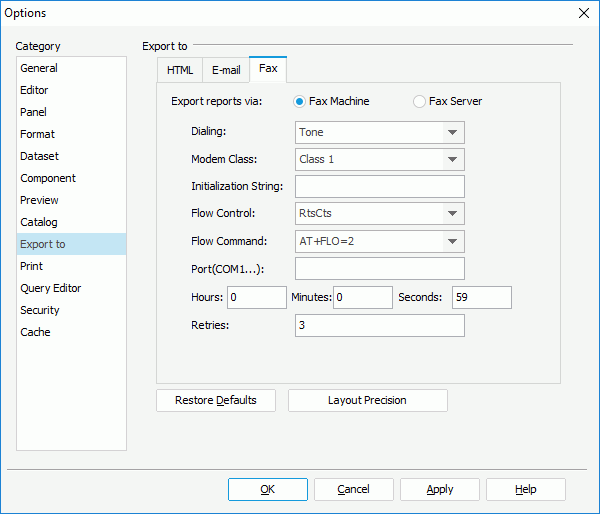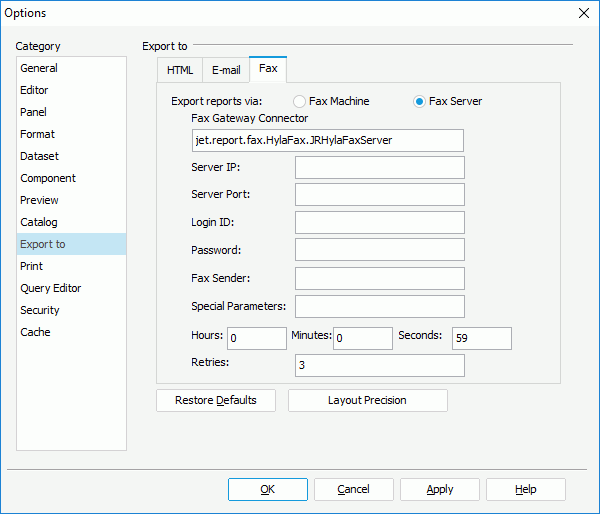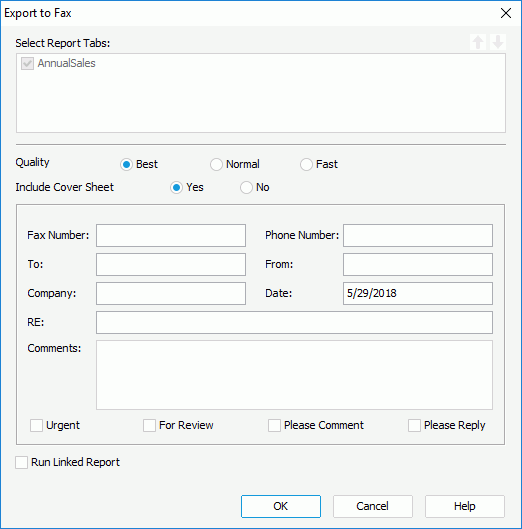Exporting to Fax
Logi JReport Designer provides the feature of exporting the report result to fax either via a fax machine or a fax server. If you require this feature to be enabled, you will first need to configure your running environment.
Below is a list of the sections covered in this topic:
Configuring the Fax Settings
To configure the settings for exporting report result to fax via a fax machine:
- Configure the running environment first. Download Java Communications API (Version 2.0): http://www.jinfonet.com/download/third_party_tool/JavaCommAPIV2_Win32.zip for Win32 or http://www.jinfonet.com/download/third_party_tool/JavaCommAPIV2_Solaris.zip for Solaris, and place the following files in the specified locations:
- For Windows:
File Name Location comm.jar <designer_install_root>\libjavax.comm.properties <Java_install_root>\jre\libWin32Com.dll <Java_install_root>\jre\bin - For Solaris:
File Name Location comm.jar <designer_install_root>/libjavax.comm.properties <Java_install_root>/jre/liblibSolarisSerialParallel.so LD_LIBRARY_PATH
- For Windows:
- Select File > Options.
- In the Options dialog, select the Export to category.
- Select the Fax tab. The Fax Machine radio button is selected by default.

- From the Dialing drop-down list, select the dialing mode for the fax modem: Tone or Pulse.
- From the Modem Class drop-down list, select the class of the modem: Class 1, Class 2 or Class 2.0. Most modems only support Class 1, so if you select Class 2 or Class 2.0, you should make sure that your modem can support it.
- In the Initialization String text box, type in the string to initialize the modem. The string should be obtained from your modem manual.
- From the Flow Control drop-down list, select the flow control mode between DTE (Data Terminal Equipment) and DCE (Data Circuit-terminating Equipment). Specifying flow control can help the compressing data function of the modem work better.
- RtsCts
Flow control of the hardware (recommended). - Xon/Xoff
Flow control of the software. - None
No flow control specified.
- RtsCts
- From the Flow Command drop-down list, select the flow control command according to the modem being used. If not contained in the drop-down list, you can leave this empty and enter the command as part of the initial string. The command should be obtained from your modem manual.
- In the Port text box, enter the port number. The port should be obtained from your modem manual.
- Specify the maximum amount of time that the fax should wait for a response from the destination before timing out.
- When the line is busy, the report result cannot be faxed, so you can specify the maximum number of times the modem re-tries faxing the report result in the Retries text box.
- Select OK to accept the settings.
To configure the settings for exporting report result to fax via a fax server:
- Select File > Options.
- In the Options dialog, select the Export to category.
- Select the Fax tab, then check the Fax Server radion button.

- In the Fax Gateway Connector text box, enter the name of the implemented class.
By default, the fax server Logi JReport uses is based on Hylafax Server, however if you want to export your report result via Hylafax Server, you need to download the gnu-hylafax packages according to your requirements from http://sourceforge.net/projects/gnu-hylafax/, for example, gnu-hylafax-util-0.0.9.2.jar, gnu-inet-ftp-0.0.9.2.jar, and gnu-hylafax-0.0.9.2.jar, and then add them to the class path of the file setenv.bat in
<designer_install_root>\bin. - In the Server IP text box, enter the IP address or domain name of the fax server.
- In the Server Port text box, enter the port number of the fax server.
- In the Login ID text box, type in the username for the class communicating with fax server.
- In the Password text box, type in the password for the class communicating with fax server.
- In the Fax Sender text box, specify the user's name that is shown in the fax server manager.
- In the Special Parameters text box, type in the parameters for the fax server.
- Specify the maximum amount of time that the fax should wait for a response from the destination before timing out. For Hylafax Server the value should not be larger than 59 seconds. It is a limitation of Hylafax Server.
- In the Retries text box, type in the number of times the modem retries faxing the report result.
- Select OK to accept the settings.
Exporting Reports to Fax
After you have configured the fax settings in the Options dialog, you can now export your reports to fax as follows:
- Open the report you want to export.
- Select File > Export > To Fax. The Export to Fax dialog appears.

- If you are exporting a page report, in the Select Report Tabs box, select the report tabs in the page report you want to export. The selected report tabs will be exported in the list order. You can select
 or
or  to change the order of the report tabs.
to change the order of the report tabs. - Specify the quality of the fax: Best, Normal, or Fast.
- Choose whether to send a cover sheet with the fax.
- Specify what you want to display on the cover sheet if you select to include it.
- Fax Number
Specifies the fax number of the recipient. - Phone Number
Specifies the phone number of the sender. - To
Specifies information of the recipient. - From
Specifies information of the sender. - Company
Specifies information of the company. - Date
Specifies the day on which the fax is sent. - RE
Specifies the subject of the fax. - Comments
Specifies some comments to the fax. - Urgent
Specifies whether the fax is urgent.
- Fax Number
- For Review
Specifies whether or not only review is required for the fax. - Please Comment
Specifies whether or not comments are required for the fax. Please Reply
Specifies whether or not a reply is required for the fax.- Check Run Linked Report if you want to generate the reports that is linked with the report (not including the detail reports) in the fax result. If you are only interested in the primary report, leave this option unchecked. Generating linked reports at the same time, especially when the linked reports contain a large amount of data, will cause performance issue.
- Select OK to start exporting.
 Previous Topic
Previous Topic